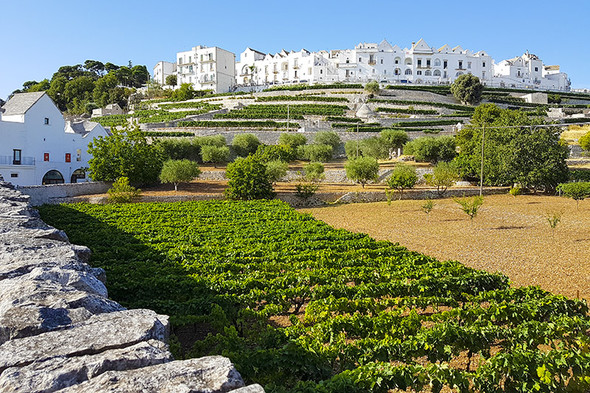I have unashamedly stolen my sub-title from large Puglian winery Torrevento, which dubs itself ’vini di un alt(r)a Puglia’ – ’wines of another Puglia’; by removing the ’r’, you then get ’wines of an ancient Puglia’. I paid a visit to the winery in the Castel del Monte DOC on the invitation of its Technical Director, Leonardo Palumbo, fellow judge at this year’s VinAgora International Wine Competition held in Budapest in July. Upon discovering we would be spending this year’s family holiday in Puglia, Leonardo promptly invited me to visit the winery.
The name Puglia conjures up oceans of easy-drinking Primitivo and perhaps two of its more well-known DOCs – Primitivo di Manduria and Salice Salentino (a blend of Negroamaro (the region’s most planted black variety) and Malvasia Nera) – will be familar to many. However, as Torrevento’s sub-title suggests, there is more to Puglia than meets the eye of the majority of wine drinkers. There are plenty of native and local grapes to be discovered in Puglia, and in the apparently endless sea of red wine, white and rosato is also produced in small pockets from grapes that few will have heard of, or indeed tasted.
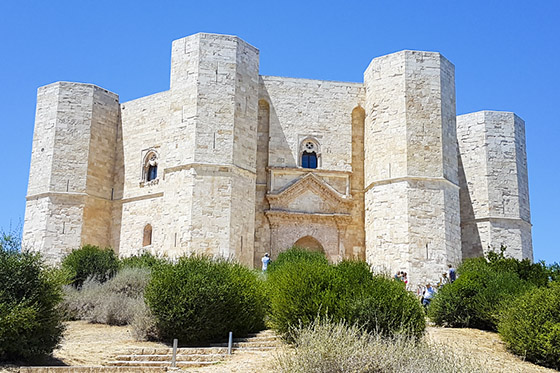
Torrevento is located in the Castel del Monte DOC, in the wildest and most rugged part of Puglia, in the middle of the Alta Murgia National Park, at the foot of the thirteenth-century castle of the same name, which commands fantastic views of the local countryside. The castle has served as a prison, a plague shelter and a source of building materials for those pilfering the castle and its contents over the years. It sits at the centre of the DOC, which also had three wines styles raised to DOCG status in 2011, all based on local varieties, now constituting three of Puglia’s four DOCGs. The two reds – Caste del Monte Nero di Troia Riserva DOCG and Castel del Monte Rosso Riserva DOCG - both take Nero di Troia (officially named Uva di Troia) as their backbone, minimum 90% for the former and 65% for the latter, with the rest made up of Aglianico and Montepulciano. Nero di Troia is the third of Puglia’s key varieties, producing well-structured, ageworthy reds with aromas of red fruits, undergrowth, roses, tobacco, black pepper and herbs. The third DOCG is, unusually, a DOCG solely devoted to rosato, the only one in Italy, so Leonardo tells me - Castel del Monte Bombino Nero DOCG. Bombino Nero, grown mostly in Puglia is a variety containing plenty of anthocyanins, so perfect for making rosato as the colour bleeds very quickly before any bitter tannins, giving a soft, well-coloured rosato with flavours of red berries. Although many people will not have heard of the Caste del Monte region, it is actually one of Puglia’s largest production zones.
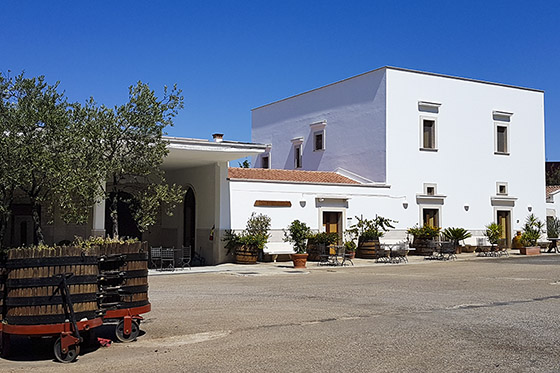
The Torrevento winery is actually an eighteenth century Benedictine monastery, situated in the ’Torre del Vento’, or Tower of the Wind district, giving rise to its name. It has been the heart of the company since the estate was acquired by the Liantonio brothers in 1948, with wines being aged in large cellars carved into the rock of the monastery. However, its roots go back much earlier, when founder Francesco Liantonio set sail for New York to seek his fortune. Having amassed enough money working in an ice factory, he returned to his beloved Puglia to realise his dream of producing and trading in wine and olive oil, one of the other staples of Puglia. Indeed, wherever you go in Puglia, ancient olive grows dot the region’s characteristic rusty-looking terra rossa soils.
The family cultivates mainly indigenous varieties in this wild, stony landscape of the limestone Murgia plateau. Alongside the DOC(G)’s flagship varieties of Uva di Troia and Bombino Nero, Torrevento cultivate Bombino Bianco, Pampanuto, Aglianico, Fiano, and the ubiquitous Chardonnay and Cabernet Sauvignon, which are only used in blends. Naturally, as a large Puglian winery, they also have other lines with local grapes sourced from elsewhere in Puglia and bearing different DOC or IGT names, including the rare sweet Moscato di Trani DOC.
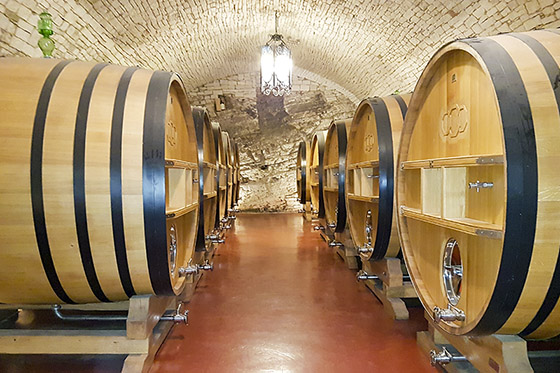
We arrived at Torrevento on a scorching hot day, in the middle of the heatwave that the Italians had nicknamed ’Lucifer’, with temperatures soaring well above 40°C. Leonardo, despite seeming to be holding the fort practically single-handedly whilst many of his colleagues were on holiday, gave us a comprehensive tour of the winery, saw us off on our way to visit Frederic II’s Castel del Monte, reserved us a table at an innovactive Puglian restaurant in the shadow of the castle, Montegusto, and generously packed up a dozen wines representative of Castel de Monte to pick up on our way back, for us to taste at our leisure. A couple of hours in the car with Lucifer’s sun beating down would have quickly turned them into mulled wine otherwise. Into the boot with two cases of ’another Puglia’, including varieties such as Pampanuto, Uva di Troia, Bombino Nero and Bombino Bianco (no relation), which thus far I had only learnt about during my Vinitaly Academy Italia Wine Ambassador course with chief Italian grape guru Ian d’Agata. Leonardo then dispatched us off to visit pictureque port town Trani, centre of the Moscato di Trani DOC. Beware, if you wish to park your car in Trani, there are no parking meters – you need to purchase a kind of ’scratch card’ from a tobacconist beforehand!
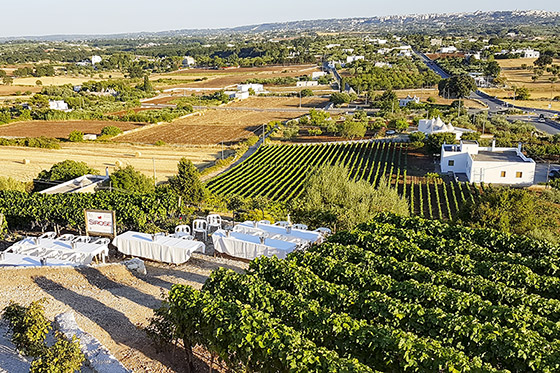
Sipping a light Torrevento white and rosato whilst gazing at our holiday home’s picture-postcard view of hilltop town Locorotondo was the perfect way to while away our last few nights in Puglia and ensured that the remaining wines, mostly reds unsuited to the baking heat, caused our cases to weigh in at just 500g under our luggage allowance. All are now safely waiting for cooler, more appropriate temperatures before tasting.



